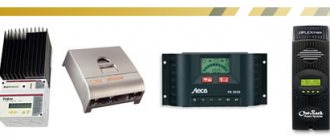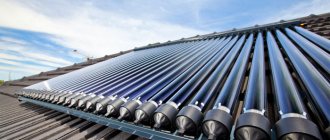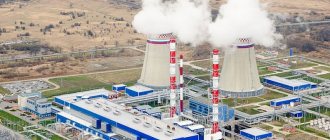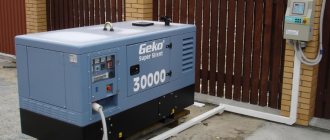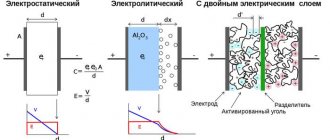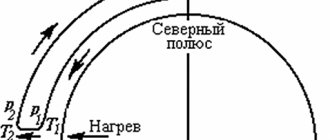The use of thermal power plants destroys the environment, and the energy sources on which they operate will one day completely exhaust themselves. Hydroelectric power plants and nuclear power plants also have their own problems associated with the complexities of construction and further operation. In this regard, in many countries much attention is paid to developments in the field of alternative sources of electricity. One of these options is a solar power plant, which uses the practically inexhaustible and available energy of the Sun.
Operating principle of a solar power plant
Solar power plants, abbreviated SES, are special structures that convert the sun's energy into electricity. Converters differ in structure and operating principle. The conversion of solar energy occurs with the help of optical elements that reflect the rays and concentrate them on a special receiver filled with water or oil. As the temperature rises, the liquid heats up, releasing steam or increasing the temperature of the coolant oil. Air masses start a generator that produces electricity.
Industrial stations are located in places of greatest solstice. To ensure efficient operation, reflective elements are equipped with mechanisms that follow the inclination of the sun's rays.
Otherwise, the efficiency of the stations would be reduced to a minimum. The concave design of the mirrors with reflective coating ensures maximum solar energy collection. For uninterrupted operation, some designs are equipped with powerful batteries, since the stations do not generate energy at night. The main advantage of these structures is the preservation of ecological peace of the environment and a constantly renewable source of solar energy. Solar stations are designed for thermal, domestic, and industrial needs.
SES using Stirling engine
They are solar power plants with parabolic concentrators with a Stirling engine installed at the focal point. There are designs of Stirling engines that directly convert piston vibrations into electrical energy, without the use of a crank mechanism. This allows for high energy conversion efficiency. The efficiency of such power plants reaches 31.25%. Hydrogen or helium is used as the working fluid.
Types and principle of operation: SES power plant
Modern solar power plants are structurally different from each other, although the technological process of energy generation is the same.
Types of SES:
- Tower structures;
- Dishes power plants;
- SES on parabolic-cylindrical concentrators;
- Solar stations with photocells or solar generators;
- Vacuum power plants.
Tower SPPs are distinguished by a special tower in the center of the elements. At its top point there is a water tank made of heat-resistant metal and coated with black paint. There are many mirrors around the tower, arranged to reflect the sun's rays onto the tank. The water heats up to high temperatures and begins to condense. The steam is fed to turbines and spins generators that produce current. Such designs supply high power.
On the hottest day, the heating temperature can reach 700 °C, which is more than enough for a high efficiency.
The only disadvantage is the large area occupied by the structure and the inability to generate energy at night. The principle of operation of dish stations is similar to a tower SES. The difference lies in the design. In this embodiment, separate modules of mirrors are used, including a reflector and a receiver with liquid. The receiver is connected to a steam generator, which produces electricity. One module will be enough for a small private house. Hundreds of devices are used on an industrial scale.
How does a solar power plant work?
Thermal power plants using parabolic cylindrical concentrators operate on a different principle. Parabolic-cylindrical mirrors are installed on an iron support, concentrated to maximize the reception of sunlight. At their focus there is a light-absorbing tube in which an oil carrier circulates, entering the heat exchanger with water. The liquid quickly heats up, turning into steam, which rotates the turbogenerator. Vacuum solar power plants use the energy of air flows due to different temperatures.
The design consists:
- From a high tower;
- Built-in turbine with electric generator;
- A piece of land covered with mirrors.
The power increases as the air flows heat up. By heating the earth, the tower can generate energy around the clock, which is an important advantage compared to other solar analogues. For solar generators, the main part of the design is the batteries, made up of many thin wafers of silicon that convert the sun's rays into electricity. To provide sufficient power, multiple batteries must be installed. Such systems are usually used for household, greenhouse and exhibition lighting.
SES tower type
Tower solar stations work on the same principle as plate ones. The basis of the system is a tower reaching a height of 18-24 m. It is located in the center of the entire installation. Tower components:
- A reservoir filled with water. To absorb maximum solar radiation, it is painted black.
- Pump group. The resulting steam must be delivered to a turbogenerator, which is what the pump does.
The second component of the station is the heliostats that surround the tower. By being included in the general positioning system, mirrors adjust to the position of the sun, changing their orientation. The temperature in the tank reaches 700 °C in bright sunny weather, and the efficiency is 20%.
Economical solar generators: operating principle
For hard-to-reach areas with intermittent power supply, solar generators become the salvation of comfortable living. With its help, you can solve energy resource problems and ensure autonomous energy supply. Mostly household generators are designed for 220 V. The devices are equipped with a display that displays a message about battery operation. The devices are installed in areas with large amounts of sunlight: the roof of a house, the walls of a building, open areas.
Solar batteries are used for backup and autonomous power supply with a wide range of uses.
Such a device will be able to ensure the operation of household equipment: a refrigerator, a washing machine, charging computer systems, heating appliances, power tools and circulation pumps. Uninterrupted operation is guaranteed for 10 - 12 hours.
The advantages of the system are:
- In autonomy;
- Independence from central supply;
- Mobility;
- Silent operation;
- Environmental safety;
- Long service life;
- Compactness;
- Ability to work in unventilated areas.
The only drawback is the cost of the device, which subsequently pays for the cost of electricity.
Pros and cons of SES
Solar generators have many advantages. The main one is environmental friendliness for the environment.
Advantages of solar power plants:
- Solar energy is constantly renewable;
- SES does not harm the environment;
- Independence from the central power supply;
- Full autonomy of the system;
- Long service life;
- Free energy resource.
The role of man in obtaining electricity in this case is reduced to zero. Generating energy in this way also has disadvantages. Purchasing equipment will require serious investment. In addition, it is necessary to purchase a battery, since at night the SES does not generate electricity. Installation of equipment requires additional space. It can be carried out on the ground, the roof of a house, or the wall of a building. Disadvantages include the need to clean the reflective surface from dust and dirt, as well as heating of the atmosphere above the surface of the equipment. The power of the generated current directly depends on weather conditions.
If you rationally approach the issue of installing solar panels, you need to take into account some nuances:
- Analyze whether there are many sunny days in the proposed area;
- Check the possibility of connecting to the central network;
- Find out how often power outages occur;
- Decide what power devices will be used in everyday life.
SPPs have quite a lot of advantages and disadvantages, but natural resources do not last forever and solar energy stations can become a worthy replacement for conventional resources.
Top 10 largest photovoltaic power plants in the world
Photovoltaic solar power plants are no longer a new product in the energy market. Recently, many countries have begun to actively switch to solar energy - a clean, inexhaustible and now relatively inexpensive source of alternative energy. There are indeed a lot of such power plants, large and small, but, probably, our readers would be interested to know where the largest of them are located.
Today we present to your attention the ranking of the Top 10 largest-scale photovoltaic power plants in the world. So, let's go!
USA, Topaz.
The largest photovoltaic plant operates in California, USA. The power plant, called Topaz, has a capacity of 550 MW. Currently, 9 million solar panels have already been installed. The power plant is located in Carrizo Plain, California, USA.
According to the authors of the project, the station's power will be enough to provide energy to 160 thousand Californian households.
Perovo Solar Power S Crimea
In 2012, the Perovo solar park (Crimea) became the largest operating photovoltaic park in the world in terms of installed capacity. Perovo consists of five phases and can meet the electricity needs of about 26,330 households.
Construction of the Perovo solar power plant began and ended on December 27, 2011.
Perovo's installed capacity is equivalent to peak loads in the power grid of nearby Simferopol. This means that during daylight hours the power plant can produce the same amount of electricity as the city consumes during peak load periods.
The capacity of the entire Perovo solar park is 105.5 MW. The station is located on an area of 200 hectares (equivalent to approximately two hundred and fifty football fields) and consists of two parts, between which there is a valley.
The solar park includes five sites on which about 440 thousand ground-mounted photovoltaic modules are installed.
The solar panels are located at an angle of 25 degrees. This is dictated by the geographical location of this site. This angle allows for maximum annual electricity production. Modules can be arranged in one, two or even four rows. The flatter the terrain, the more rows you can make. Solar station "Perovo" is single-row.
Canada. Sarnia Photovoltaic Power Plant
This power plant maintained its leadership in the field of photovoltaic plants for a very long time. The project, developed and implemented by First Solar, has a total capacity of 97 MW and was completed in September 2010. The power plant operates under a feed-in program established by the Canadian government to stimulate the supply of alternative energy. Under this program, the government subsidizes solar energy projects to increase the price of the energy they produce without hurting demand.
The power plant covers an area of 380 hectares and consists of more than 1.3 million flexible solar panels. The annual electricity output from the project is 120 thousand MWh, and the savings in carbon monoxide emissions are 39 thousand tons per year.
Italy. Montalto di Castro PV Power Plant
The power plant is located near Viterbo, Italy and is the largest photovoltaic plant in the country. The project was developed in several stages, starting in 2009 by the independent vendor SunRay, but was then purchased by the giant SunPower. At that time, the total capacity of the power plant was 44 MW, but now this figure has increased to 84.2 MW, which allowed Montalto di Castro to take an honorable third place in the ranking.
Germany. Solarpark Senftenberg II,III
This power plant is located near the city of Senftenberg in East Germany on territory that was previously used for coal mining. The project, which was last updated in 2011, has a capacity of 82 MW and consists of more than 330 thousand crystalline solar modules. Such an energy complex is capable of providing electricity to about 25 thousand homes. It is noteworthy that the construction of the project was completed in a record time of 3 months, and the cost was 150 million euros.
Germany. Solarpark Finsterwalde I,II,III
This solar station topped this rating until November 2010. The total capacity of the project, which is located near the city of Finsterwalde, Germany, is 80.245 MW. The solar park is a joint project between LDK Solar and Q-Cells International and was developed in three stages over 2009-2010.
Crimea. Ohotnikovo PV Power Plant
Another project by Activ Solar. The power plant was completed on October 21, 2011, becoming one of the largest photovoltaic power plants in Europe and the world. The station covers about 160 hectares and consists of 360 thousand solar modules capable of producing a power of 80 MW. These indicators will allow the power plant to produce 100 thousand kWh of electricity per year, which will provide electricity to 20 thousand households. At the same time, the power plant will reduce carbon monoxide emissions by 80 thousand tons per year.
Thailand. Lopburi PV Power Plant
Another sunny bird that spread its wings last year. The solar project, located in Lopburi Province, Thailand, has a total capacity of 73 MW and was commissioned on December 25, 2011. Construction lasted 18 months and cost $70 million.
According to officials, the project over its 25-year life will help reduce carbon dioxide emissions by 1.3 million tons, as well as reduce fuel imports by 35 thousand tons per year.
Germany. Solarpark Lieberose
The ninth position in the ranking of the largest photovoltaic stations in the world was taken by another German project, located in Liberos, Brandenburg, Germany. The solar park is owned by Juwi Group, which has a 20-year contract for the use of the land. The project was commissioned in 2009 and has a total capacity of 71 MW. The park includes about 700 thousand flexible solar panels that power more than 15 thousand homes. It should be noted that the solar panels used in this project are among the most efficient today.
Italy. San Bellino PV Power Plant
This project was launched on October 30, 2010 in San Bellino, Italy. The facility, which cost 250 million euros, was built by the American company SunEdison. Construction was completed in 9 months, however, before that, it took another two years to coordinate the project with local authorities. Pancho Perez, general director of the company's European office, said that this achievement was due to partnerships with local companies. The power plant's capacity of 70.556 MW will be enough to provide electricity to 16 thousand families, while carbon dioxide emissions will be reduced by 40 thousand tons per year.
As for the number of projects, Germany is the undisputed leader here. The country's largest photovoltaic projects have a total capacity of 672 MW. By a wide margin, Italy ranks second in terms of power (316 MW), and Spain (264 MW) completes the top three. This project was launched on October 30, 2010 in San Bellino, Italy. The facility, which cost 250 million euros, was built by the American company SunEdison. Construction was completed in 9 months, however, before that, it took another two years to coordinate the project with local authorities. Pancho Perez, general director of the company's European office, said that this achievement was due to partnerships with local companies. The power plant's capacity of 70.556 MW will be enough to provide electricity to 16 thousand families, while carbon dioxide emissions will be reduced by 40 thousand tons per year.
It may seem that all solar stations have a simple rectangular shape, but this is not so.
A heart-shaped solar power plant has been built in New Caledonia. This solar power plant rightfully holds the title of the most beautiful.
The heart-shaped 2MW solar power plant powers 750 homes on a Pacific island, reducing carbon emissions and preserving the natural beauty of the surrounding area.
New Caledonians have initiated the construction of a solar farm to help reduce the French territory's dependence on foreign energy. Over 25 years of operation, the solar farm will help prevent about 2 million tons of harmful emissions from entering the atmosphere.
The shape of the power plant was inspired by a naturally grown heart-shaped grove of mangrove trees known as the "Coeur de Voh". "Coeur de Voh is an important site for the people of New Caledonia, showing how extraordinary nature can be," said Managing Director of Conergy. “The Heart of New Caledonia solar array will be a man-made replica of a mangrove and an iconic clean energy facility.”
Solar power plant diagram: what to look for when purchasing
Autonomous solar power plants for the private sector are most in demand for backup power supply to the private sector.
The thermal battery diagram represents a single block with a removable cover, consisting of elements:
- Photo panels for creating current;
- Storage battery;
- Inverter, for converting current;
- The charge controller promotes the accumulation of resources in the battery.
When choosing a generator, you need to pay attention to some nuances. The number of solar panels is selected in accordance with the load, the required operating time and the geographical location of the facility. Wires must be equipped with waterproof connectors. When choosing a charge controller, it is better to choose a modern MPPT device. The DC switch is an important element. First, it protects controllers from burnout. Secondly, it allows for safe maintenance of the complex, which must be provided at least 2-3 times a year.
In addition, care must be taken to provide protective grounding for devices and people.
SES on photovoltaic modules
Photovoltaic solar stations are considered classic. They are based on the use of solar panels and modules. If power supply is required for small objects, modules without silicon elements are used. They are installed on roofs or on a piece of land.
For industrial facilities, more powerful photo batteries are provided, which occupy significant areas. The operating principle of such a solar power plant is simple. To produce electricity, the energy of light photons is converted. The station can operate a single pump or supply electricity to an entire village. It all depends on the number and power of panels. They are especially common in the private sector. Choosing the right solar battery for your home is not difficult.
